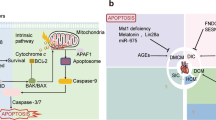Abstract
Apoptosis as defined by contemporary science describes a form of cell death that involves discrete genetic and molecular programs, de novo protein expression and unique cellular phenotype. Evidence for the existence of apoptosis in the human heart has been reported in various cardiac diseases, including ischemic and non-ischemic heart failure, myocardial infarction and arrhythmias. Among the most potent stimuli that elicit cardiomyocyte apoptosis are: oxygen radicals (including NO), cytokines, (e.g., TNFα, FAS) neurohormonal factors (angiotension II), cardiotoxic drugs (e.g., doxorubicin) and mechanical, stretch situations. Several complex signal transduction pathways have been implicated in execution of cardiomyocyte apoptosis. Most prominent are: 1) Tyrosine kinase receptors (TRK) induced signaling involving stress or mitogen activated protein kinases (SAPK/MARK) and sphingolipids metabolites (ceramide); 2) G-protein coupled receptor (GPCR) signaling (Gαi, Gαq) and 3) NFK B activation. Apoptosis of cardiac myoctyes may contribute to progressive pump-failure, arrhythmias and cardiac remodeling. The recognition of diverse molecular targets associated with cardiomyocyte apoptosis provide new opportunities for pharmacologic manipulation, that may lead to discovery and development of therapeutic strategies for treatment of heart failure, arrhythmias and myocardial infarction.
Similar content being viewed by others
References
Kerr J, Wyllie A, Currie A. Apoptosis:Abasic biological phenomenon with wide ranging implications in tissue kinetics. Br J Cancer 1972; 26: 239-257.
Yuan J, Shaham S, Ledous S, Ellis H, Horvitz H. The C. elegans cell death gene ced-3 encodes a protein similar to mammalian interleukin-1)β-converting enzyme. Cell 1993; 75: 641-652.
Anversa P, Leri A, Beltrami C, Guerra S, Kajstura J. Myoctye death and growth in failing heart. Lab Invest 1998; 78: 767-786.
Narula J, Haider N, Virmani R, et. al. Apoptosis in myocytes in end-stage heart failure. New Engl J Med 1996; 335: 1182-1189.
Feuerstein G, Young P. Apoptosis in cardiac diseases: Stress and mitogen activated signaling pathways. Cardiovascular Res 2000; 45: 560-569.
Yaoita H, Ogawa K, MaeLare K, Maruyama Y. Attenuation of ischemia/repercussion injury in rats by a caspase inhibitor. Circulation 1998; 97: 276-281.
Yue T, Ma X, Wang X, et. al. Possible involvement of stressactivated protein kinase signaling pathway and Fas receptor expression in prevention of ischemia/reperfusion-induced cardiomyocyte apoptosis by carvedilol. Cir Res 1998; 82: 166-174.
Torre-Amione G, Kapadia S, Lee J, et al. Tumor Necrosis Factor α and tumor necrosis factor receptors in the failing human heart. Circulation 1996; 95: 704-707.
Szabolcs M, Michler R, Yang X, et al. Apoptosis of cardiac myocytes during cardiac allograph rejection: Reaction to induction of nitric oxide synthase. Circulation 1996; 94: 1665-1673.
Fortuno M, Ravassa S, Etayo J, Diez J. Overexpression of Bax protein and enhanced apoptosis in the left ventricle of spontaneously hypertensive rats. Effects of AT, blockade with losartan. Hypertension 1998; 32: 280-286.
Salvesen G, Dixit V. Caspases: Intracellular signaling by proteolysis. Cell 1997; 91: 443-446.
Finkle E. The mitochondrion: Is it central to apoptosis? Science 2001; 292: 624-626.
Hofmann K, Dixit V. Ceramide in apoptosis-does it really matter? Trends in Biochem Science 1998: 374-377.
Feuerstein G, Rozanski D. Is Gαq a target for heart failure? Circulation Research 2000; 87: 1085-1086.
Adams J, Sokata Y, Davis M, et al. Enhanced Gαq signaling: A common pathway mediates cardiac hypertrophy and apoptotic heart failure. Prot Natl Acad Sci 1998; 95: 10141-10145.
Wei M, Zong W-X, Cheng E, et al. Proapoptotic Bax and Bak: A requisite gateway to mitochordrial dysfunction and death. Science 2001; 292: 727-730.
Black S, Huang J, Rezaiefar P, et al. Co-Localization of the cystein protease caspase-3 with apooptotic myocytes after in vivo myocardial ischemia and reperfusion in rats. J Mol Cell Cardiol 1998; 30: 733-742.
Ma X, Kumar S, Gao F, et al. Inhibition of p38 mitogen activated protein kinase decreases cardiomyocyte apoptosis and improves cardiac function after myocardial ishcemia and reperfusion. Circulation 1999, in press.
Adams J. Oral presentation. The 9th Cyprus Conference on New Methods in Drug Research, May 18-24. 2001.
Cleland J, Feuerstein, G. Focus on carvedilol for heart failure. Heart Failure Reviews 1999; 4: 5-6.
Packer M, Antonopoulos G, Berlin J, Chittams J, Konstam M, Udelson J. Comparative effects of carvediol and metoprolol on left ventricular ejection fraction in heart failure: Results of a meta-analysis. Am Heart J 2001; 141: 899-907.
Kaye D, Johnston L, Vaddadi G, Brunner-LaRocca H, Jennings G, Esler M. Mechanisms of carvedilol action in human congestive heart failure. Hypertension 2001; 37: 1216-1221.
Author information
Authors and Affiliations
Rights and permissions
About this article
Cite this article
Feuerstein, G.Z. Apoptosis—New Opportunities for Novel Therapeutics for Heart Diseases. Cardiovasc Drugs Ther 15, 547–551 (2001). https://doi.org/10.1023/A:1013775906652
Issue Date:
DOI: https://doi.org/10.1023/A:1013775906652




